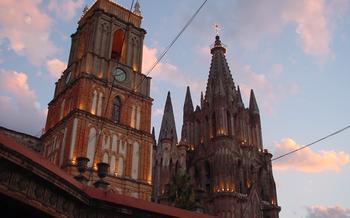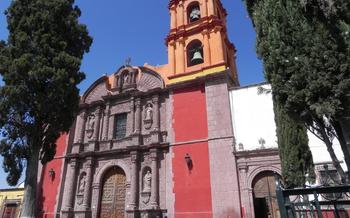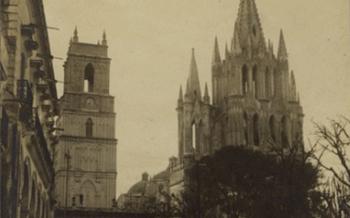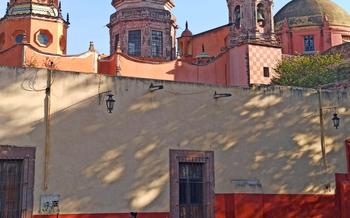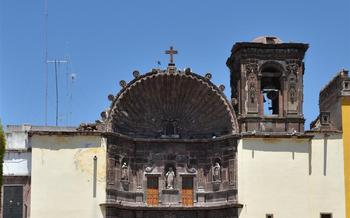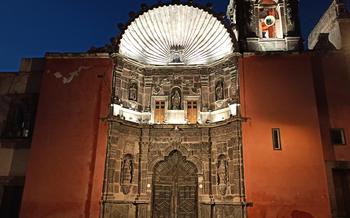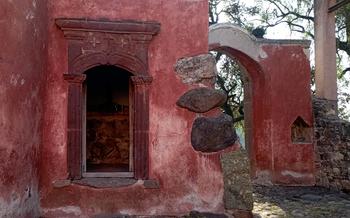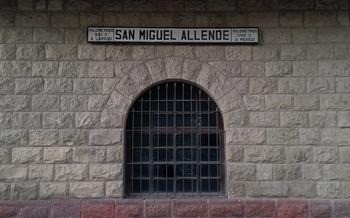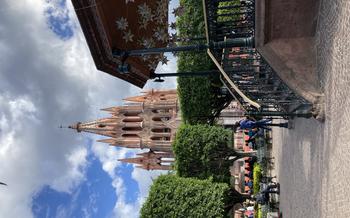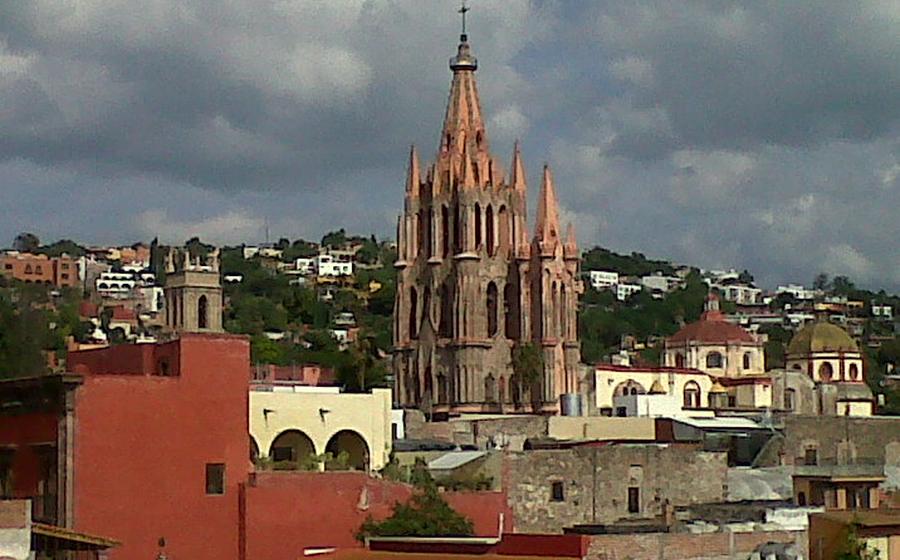
Parroquia de San Antonio
- A Labor of Love: The Construction of the Parish
- Exploring the Grand Facade
- Stepping Inside the Sanctuary
- The Story of the Miraculous Image
- Climbing the Iconic Towers
- Discovering the Hidden Chapel
- Attending a Mass or Religious Service
- Admiring the Ornate Altars
- Exploring the Museum and Archives
- Participating in the Annual Festivals
- Learning about the Restoration Efforts
- Appreciating the Local Craftsmanship
- Capturing the Perfect Photo
- Insider Tip: Hidden Gems Nearby
A Labor of Love: The Construction of the Parish
In the heart of San Miguel de Allende, the construction of the Parroquia de San Antonio was a labor of love, a testament to the dedication and perseverance of the local community. Local indigenous communities and skilled craftsmen played a pivotal role, contributing their expertise and artistry to create a masterpiece that would become a symbol of devotion and architectural prowess.
The visionary force behind the project was Father Luis Felipe Neri de Alfaro, a priest who dreamed of building a church that would rival the grand cathedrals of Europe. He tirelessly rallied the community, seeking donations and organizing construction efforts. Despite challenges and delays, Father Neri de Alfaro's unwavering determination ensured that the Parroquia would rise as a beacon of faith and perseverance.
One notable challenge arose when the church's original foundations proved unstable. With unwavering faith, Father Neri de Alfaro ordered the construction of new foundations, demonstrating his commitment to creating a lasting legacy. The church's construction spanned several decades, with various architects and artisans contributing to its unique blend of architectural styles.
During the restoration of the Parroquia in the 20th century, a hidden treasure was discovered beneath the altar: a cache of gold coins and religious artifacts. This unexpected find provided a glimpse into the church's rich history and the devotion of its early parishioners. Today, the Parroquia de San Antonio stands as a testament to the enduring spirit of the community that built it, a symbol of faith, resilience, and architectural brilliance.
Exploring the Grand Facade
The Parroquia de San Antonio's grand facade is a masterpiece of Mexican Baroque architecture, showcasing intricate stone carvings that depict religious motifs and symbols. The stunning pink sandstone exterior, a defining characteristic of the church, adds to its visual appeal and makes it a true standout. The Churrigueresque style, characterized by its elaborate ornamentation and dynamic forms, is evident throughout the facade, contributing to its overall grandeur.
To capture the most vibrant photos of the facade, it is recommended to visit during the golden hour, when the warm light enhances the intricate details and casts a magical glow on the sandstone exterior. Whether you're a professional photographer or simply an enthusiast, the Parroquia de San Antonio's facade is a true canvas for capturing stunning images.
Stepping Inside the Sanctuary
Stepping inside the Parroquia de San Antonio is a truly awe-inspiring experience. The grand interior features vaulted ceilings that soar high above, creating a sense of sacredness and grandeur. The intricately carved altarpieces, adorned with gold leaf and vibrant colors, draw the eye towards the center of the sanctuary. The interplay of light and shadow through the stained glass windows creates a magical atmosphere, illuminating the beautiful artwork and religious iconography that adorns the walls.
The collection of religious artifacts, paintings, and sculptures housed within the church is a testament to its rich history and devotion. Visitors can admire the delicate woodwork of the choir stalls, the intricate silverwork of the candlesticks, and the stunning paintings that depict scenes from the Bible. Each piece tells a story, offering a glimpse into the faith and beliefs of the community.
As I stood in the quiet sanctuary, I couldn't help but feel a sense of tranquility and peace. The beauty of the surroundings and the devotion of the local residents created an atmosphere that was both inspiring and calming. It was a moment of reflection and contemplation, where I could appreciate the grandeur of this architectural masterpiece and the deep spiritual connection it holds for the people of San Miguel de Allende.
The Story of the Miraculous Image
In the heart of the Parroquia de San Antonio, a revered icon known as the Virgin of the Immaculate Conception holds a special place in the hearts of San Miguel de Allende's residents. Legend has it that this sacred image was discovered by a local shepherd boy in a nearby cave, radiating a divine glow. News of the miraculous finding spread like wildfire, attracting pilgrims from far and wide who sought blessings and healing from the Virgin.
The devotion to the Virgin of the Immaculate Conception grew profoundly over the centuries, becoming an integral part of the city's religious and cultural identity. The annual feast day celebration, held on December 8th, is a testament to the enduring faith and veneration of the local community. During this grand festival, the streets of San Miguel de Allende come alive with vibrant processions, traditional dances, and heartfelt prayers, as devotees honor their beloved patroness.
Insider Tip: To fully immerse yourself in the local traditions, be sure to attend the traditional processions and festivities held in honor of the Virgin of the Immaculate Conception. Witness the deep devotion and vibrant cultural expressions that make this annual celebration so special.
Climbing the Iconic Towers
Prepare for an unforgettable adventure as you embark on the ascent to the top of the Parroquia de San Antonio's iconic towers. The climb is not for the faint of heart, as you'll navigate narrow staircases and tight spaces, but the breathtaking panoramic views that await you at the summit are well worth the effort.
As you ascend, you'll be rewarded with stunning vistas of San Miguel de Allende and its picturesque surroundings. The city's colorful colonial architecture, vibrant plazas, and rolling hills create a captivating landscape that will leave you in awe.
To fully appreciate the experience, plan your climb during the golden hour, just before sunset, when the warm hues of the setting sun cast a magical glow over the city. The play of light and shadow on the church's facade and the surrounding landscape creates a truly unforgettable spectacle.
While the climb can be challenging, it's important to prioritize safety. Wear comfortable shoes with good traction, and be cautious when navigating the narrow staircases. If crowds are a concern, consider visiting during off-peak hours to avoid congestion.
Once you reach the top, take a moment to soak in the panoramic views and capture some stunning photos to cherish your experience. The breathtaking vistas from the towers of the Parroquia de San Antonio will undoubtedly leave an indelible mark on your memories of San Miguel de Allende.
Discovering the Hidden Chapel
Tucked away within the Parroquia de San Antonio is a hidden gem waiting to be discovered—the Capilla de la Tercera Orden. Built in the 18th century, this intimate chapel exudes a serene and spiritual atmosphere. Its walls are adorned with exquisite frescoes and artwork, depicting biblical scenes and the lives of saints.
The most captivating feature of the Capilla de la Tercera Orden is its peaceful ambiance. In contrast to the grandeur of the main church, this hidden chapel offers a sanctuary for quiet contemplation and prayer. Visitors can escape the hustle and bustle of the outside world and find solace within these sacred walls.
During my visit, I took a moment to sit in the chapel's pews and reflect on the beauty and history that surrounded me. The soft light filtering through the stained glass windows cast a warm glow on the intricate artwork, creating an ethereal atmosphere that invited introspection and meditation.
Whether you're a devout believer seeking spiritual reflection or simply an admirer of history and art, the Capilla de la Tercera Orden is a hidden treasure that should not be missed. Take a moment to step into this sacred space and let its tranquility wash over you.
Attending a Mass or Religious Service
Step inside the Parroquia de San Antonio during a mass or religious service to witness the vibrant and spiritual traditions of the local community. The atmosphere is filled with devotion and reverence as the congregation gathers to celebrate their faith. The beauty of the liturgical music and the participation of the congregation create a sense of unity and spirituality.
As a visitor, you'll have the opportunity to observe the rituals and customs of the Catholic Church in Mexico. Dress respectfully and follow the local customs, such as standing during the Gloria and kneeling during the consecration.
Attending a mass or religious service at the Parroquia de San Antonio is a unique and enriching experience that offers a glimpse into the deep religious beliefs and traditions of the Mexican people.
Admiring the Ornate Altars
The interior of the Parroquia de San Antonio is adorned with a series of intricate altars that showcase the exceptional craftsmanship and artistry of the Baroque era. The main altar, known as the Altar Mayor, is a masterpiece of gilded woodcarving, featuring intricate designs, cherubs, and religious figures. The side altars, dedicated to various saints and adorned with colorful tiles, paintings, and sculptures, are equally impressive.
Each altar tells a story through its elaborate iconography, depicting scenes from the Bible, the lives of the saints, and the history of the church. The central altarpiece, dedicated to the Virgin of the Immaculate Conception, is particularly noteworthy for its exquisite detail and symbolism. The combination of carved wood, painted figures, and shimmering gold leaf creates a mesmerizing spectacle that draws the eye upwards towards the heavens.
For those interested in learning more about the symbolism and stories depicted in the altars, consider hiring a local guide who can provide in-depth explanations and insights. Their knowledge will help you appreciate the rich cultural and religious heritage embodied in these sacred works of art.
Exploring the Museum and Archives
Nestled within the Parroquia de San Antonio complex is a treasure trove of history and religious artifacts, housed in the Parroquia de San Antonio Museum and Archives. This hidden gem offers a fascinating glimpse into the construction, restoration, and daily life of the parish.
The museum's collection includes a diverse array of religious artifacts, such as vestments, chalices, and processional banners, each with its own unique story to tell. Visitors can also delve into the historical records of the parish, gaining insights into the lives of the priests and parishioners who have shaped its history.
One of the highlights of the museum is a forgotten piece of history that was discovered during the restoration process. A hidden chamber was uncovered, revealing a collection of ancient documents and relics that had been lost for centuries. This discovery shed new light on the history of the parish and provided valuable insights into the lives of its earliest members.
Whether you're a history buff, a religious scholar, or simply curious about the inner workings of a centuries-old parish, the Parroquia de San Antonio Museum and Archives is a must-visit. Take your time to explore the exhibits, and don't forget to ask the knowledgeable staff for more information about the fascinating stories behind the artifacts.
Participating in the Annual Festivals
The Parroquia de San Antonio comes alive during the annual festivals celebrated in San Miguel de Allende. These vibrant events showcase the city's rich cultural heritage and provide an immersive experience for visitors.
The most significant festival is the Feast of the Virgin of the Immaculate Conception, held on December 8th. This grand celebration honors the patron saint of the parish and features colorful processions, traditional dances, and music performances. The streets are adorned with festive decorations, and the air is filled with the sounds of music and laughter.
Other notable festivals include the Semana Santa (Holy Week) processions, the Festival de las Animas (Day of the Dead), and the Festival de San Miguel Arcángel (Feast of Saint Michael the Archangel). Each festival has its unique traditions and rituals, offering a glimpse into the deep-rooted faith and cultural practices of the local community.
Insider tip: For the best views of the processions, secure a spot along the designated route early. Remember to dress respectfully and be mindful of local customs during these religious celebrations.
Learning about the Restoration Efforts
Preserving a historical landmark like the Parroquia de San Antonio is a complex and challenging task. Over the years, the church has undergone several restoration projects to maintain its structural integrity and original beauty. Visitors can learn about these efforts by joining guided tours led by experts who explain the techniques and materials used in the restoration process.
One of the key challenges faced during the restoration was addressing the damage caused by natural elements, such as earthquakes and humidity. Skilled artisans and craftsmen worked meticulously to repair and reinforce the church's foundations, walls, and intricate stone carvings. They used traditional techniques and materials, such as lime mortar and carved cantera stone, to ensure that the repairs blended seamlessly with the original fabric of the building.
The restoration team also focused on preserving the church's interior, including its stunning frescoes, paintings, and sculptures. Conservators carefully cleaned and restored these artworks, using specialized techniques to ensure that their vibrant colors and intricate details were preserved for future generations.
By learning about the restoration efforts at the Parroquia de San Antonio, visitors gain a deeper appreciation for the dedication and skill required to maintain this iconic landmark. Guided tours offer a unique opportunity to understand the challenges and complexities involved in preserving a piece of Mexico's rich cultural heritage.
Appreciating the Local Craftsmanship
The Parroquia de San Antonio is a testament to the skill and artistry of the local craftsmen and artisans who contributed to its creation. Visitors can admire the intricate stone carvings, delicate frescoes, and ornate woodwork that adorn the church's interior and exterior. These artisans used traditional techniques and materials, such as carved stone, painted tiles, and hand-forged iron, to create objects of great beauty and significance.
Strolling through the streets surrounding the church, visitors can find numerous shops and workshops where local artisans continue to practice their traditional crafts. Here, they can purchase unique souvenirs and handmade items, such as pottery, textiles, jewelry, and religious objects. These crafts are not only beautiful but also carry cultural and historical significance, representing the rich traditions of San Miguel de Allende.
When bargaining for crafts, it is important to be respectful and fair. Engage with the artisans, learn about their work, and offer a reasonable price that reflects the time and skill involved in creating each piece. By supporting local artisans, visitors not only take home a piece of Mexican culture but also contribute to the preservation of traditional crafts and the livelihoods of these talented individuals.
One personal anecdote I have about bargaining is from a time when I was purchasing a beautiful hand-painted ceramic plate. The artisan initially asked for a high price, but after a friendly conversation and expressing my admiration for his work, we were able to negotiate a fair price that both of us were happy with. I left the shop feeling satisfied with my purchase and grateful for the opportunity to support the artisan's craft.
Capturing the Perfect Photo
Photographers flock to the Parroquia de San Antonio for its picturesque beauty. Here are some tips for capturing the perfect shot:
-
Golden Hour Magic: Visit during sunrise or sunset when the warm, golden light illuminates the church's facade, creating a stunning contrast against the blue sky.
-
Embrace the Details: Use a macro lens to capture the intricate carvings on the facade, showcasing the craftsmanship and artistry.
-
Play with Perspectives: Experiment with different angles to create dynamic compositions. Shoot from below to emphasize the grandeur of the towers or capture unique shots from the surrounding streets.
-
Avoid Crowds: To avoid unwanted distractions, arrive early in the morning or late in the afternoon when there are fewer tourists.
-
Seek Symmetry: Position yourself directly in front of the church to capture the perfect symmetry of the towers and facade.
Insider Tip: Hidden Gems Nearby
While exploring the Parroquia de San Antonio, take the time to wander through the enchanting streets of San Miguel de Allende. Discover hidden gems such as the Museo Histórico de San Miguel de Allende, which showcases the city's rich history and culture. Explore the vibrant local markets, where you can find unique souvenirs and sample delicious Mexican delicacies. For a peaceful retreat, head to the Jardín Allende, a charming central plaza surrounded by colorful colonial buildings and lush greenery. Immerse yourself in the local culture by attending traditional festivals and events, such as the annual Fiestas de San Miguel, where you can witness vibrant processions, music, and dance performances.
